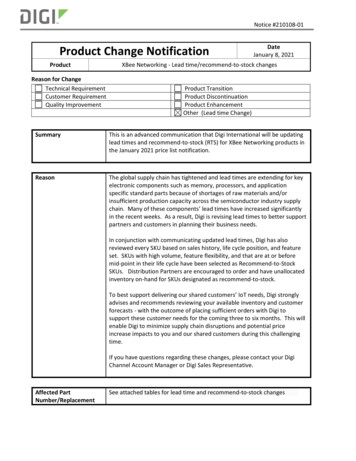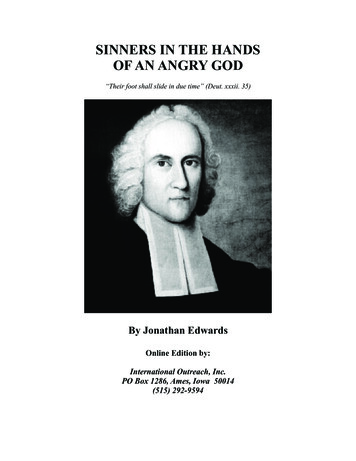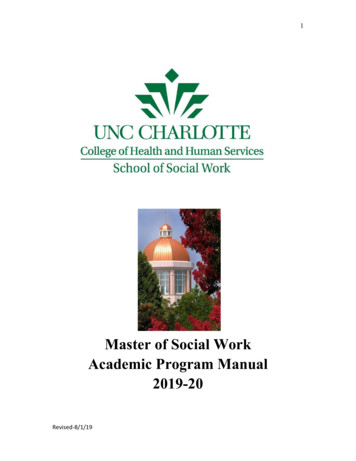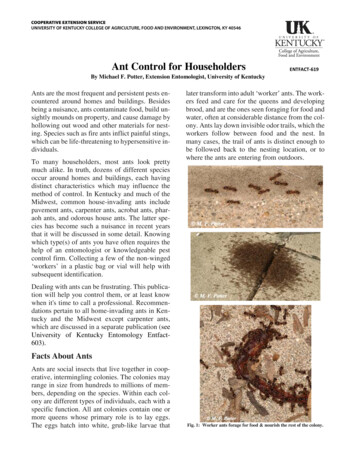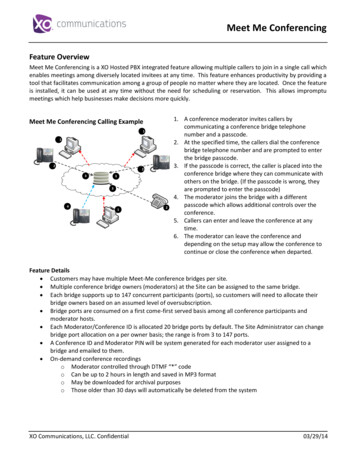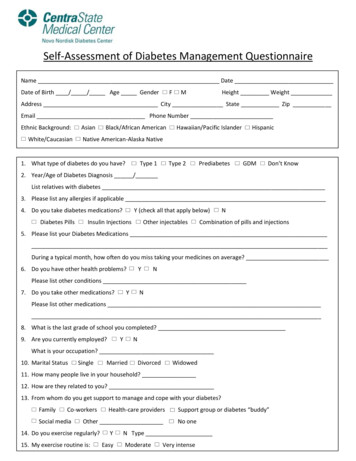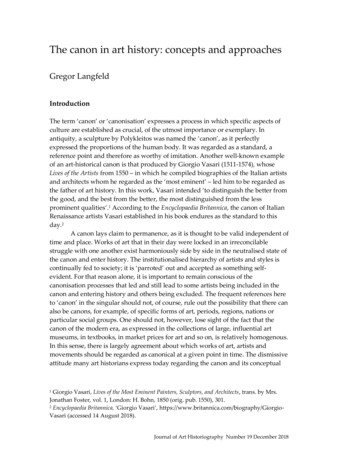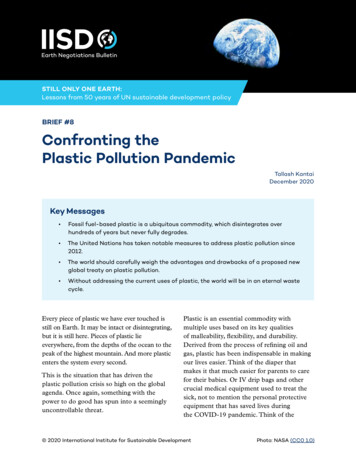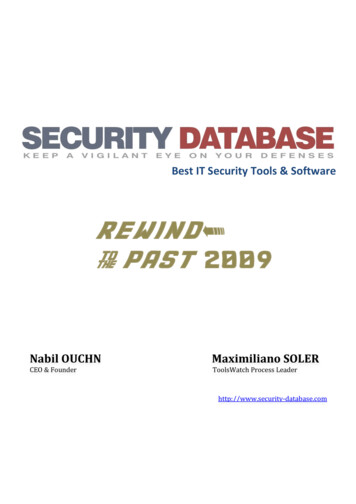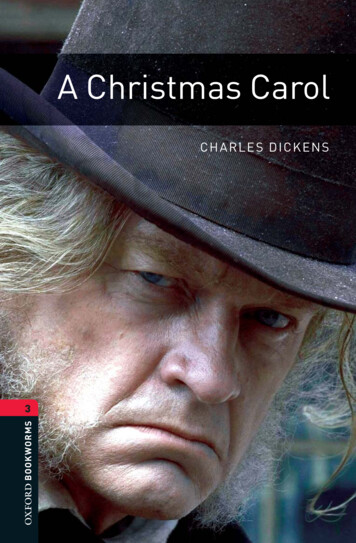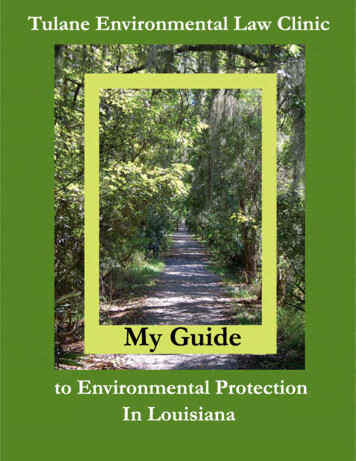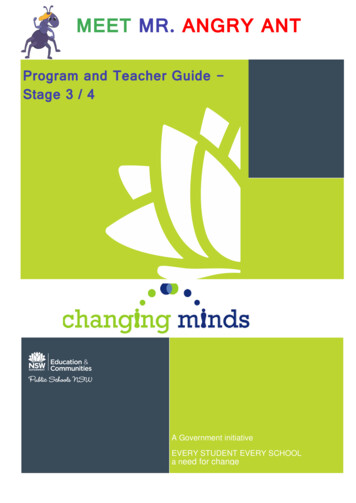
Transcription
MEET MR. ANGRY ANTProgram and Teacher Guide Stage 3 / 4A Government initiativeEVERY STUDENT EVERY SCHOOLa need for change
Verona School, Campbell House School, Karningul SchoolMeet Mr Angry Ant!Program and Teacher GuideDeveloped by Jennifer Jones, 2013
Meet Mr Angry Ant!Program & Teacher GuideDeveloped by Jennifer Jonesin consultation with:Robert PatrunoMarisa PjanicCheryl StambolisNathan EldredDISCLAIMER:While “Meet Mr Angry Ant!” was designed in consultation with educators and researchers, this program assumesno liability for the information provided. It is not intended to be a one-stop solution for anger-management issuesexperienced by individuals or groups and is meant for educational purposes only. It does not come with an expressor implied warranty and assumes no liability for loss or damage. If the issues touched on in any of the programmaterials cause distress for anyone engaging with it, the following websites and contact numbers may be useful:Beyond Bluewww.beyondblue.org.auPh: 1300 22 4636Helplinewww.sane.orgPh: 1800 18 7263Kids Helplinewww.kidshelp.com.auPh: 1800 55 1800Lifeline Australiawww.lifeline.org.auPh: 13 11 t:Jennifer Jones would like to acknowledge the influence of Dr Paul Dufficy,formerly a TESOL and Primary Education Lecturer at the University of Sydney, whosedeveloping model of Engagement, Exploration, Transformation, Presentation and Reflection hasinformed significantly her own thinking about pedagogical staging and lesson design.These terms and general concepts are taken from handouts he provided to students in hisTESOL Methodology classes offered as part of the Master of Teaching 1996-1997.Jennifer acknowledges that her own pedagogical and literacy and language teaching rationale isderived from Dr Paul Dufficy’s original framework.2013
Table of Contents1. Teaching & Learning Program Overview2. Options for Program Delivery:312How the sections of the picture book correspond with the suggested sequencing ofteaching/ learning activities & other options for program delivery3. Detailed Teacher Guide, broken up by SectionSections include: Key Focus What is the Text doing? Background Information for Teachers Focus Questions Pedagogical Staging Suggested Activity Sequence Related or Extension Activities Word Bank Suggested Resources/ Helpful Links/ ReferencesSection 1: Orientation & Complication .Section 2: Description .Section 3: Possible Explanations Section 4: Suggested Strategies . .Section 5: Reinforcing Coda 4. Questions for Facilitating Class Discussion of the Book:17182125293335Page by Page breakdown5. Main Activity CardsSection 1: Orientation & Complication Yes, No, Maybe: Reading & classification task Volcano of Emotions: Class poster and vocabulary task424346Section 2: Description Volcanic Eruption: When anger takes off (sequencing task) Mapping the Physiology of Anger: Class poster and reading task Making Anger Masks Part 1 (anger)505459Section 3: Possible Explanations Making Anger Masks Part 2 (underlying emotions) Maslow’s Hierarchy of Needs: Reading, matching & sequencing task Picturing Your Quality World: Visual representation task626772Section 4: Suggested Strategies Taking your Anger Outside: The effect of nature on calming you down Emotional Thermometer11 “Music Therapy”: Listening task12 Class Survey: What helps you manage your anger?13 Strategies Posters14 Hot-seat: Interviewing the Angry Ant778086909297
15 Mapping our Learning so far: Learning Map, Graphic Organisers & Story Cube16 Designing and Making a Cooperative Board Game104110Section 5: Reinforcing Coda17 Class Quiz Game18 Self-Reflection Proformas122129Main Extension Activities19 Mathematics Task: Relative & Brute Strength20 Vocabulary Enrichment Task (Visual Arts & English): “Colours”6. Additional Activity Copy MastersPrint Master 1: Y-chart: What does my school feel like/ look like/ sound like?Print Master 2: Freeze Frame – How do you know the ant is angry? & MusicalStatues exercisePrint Master 3: Freeze Frame – How is anger like a volcano?Print Master 4: Text & Unit Structure: Poster of Picture Book textual organisation,student worksheet for understanding the sections of the book, Unitoverview – with activities referenced to the book’s key sectionsPrint Master 5: Y-chart: What does anger feel like/ look like/ sound like?Print Master 6: Concept Map: What is anger?Print Master 7: Cause & Effect Graphic Organiser: Mapping the Angry Ant’s angrybehaviour, its possible causes and consequencesPrint Master 8: Scenarios Tables: Outward reactions and underlying emotions7. Additional Tools and ResourcesEmotional Regulation (Source: Warby Behaviour Intervention Program)List of Common Concerns (Source: Warby Behaviour Intervention Program)135141147148149150151154155156157160161163
1. Unit Overview3 Page
PROGRAMTITLE“Meet Mr Angry Ant!”This Program is based on the children’s picture book: Meet MrAngry Ant! by Robert Patruno and Marisa PjanicSTAGE LEVELPitched with Stage 3 and early Stage 4 outcomes in mind, this Program is designed forimplementation with upper primary/ lower secondary students.DURATIONThis Program has flexible delivery options. There are 20 Activity Cards, two of which are ExtensionTasks, and all may be used selectively, although a suggested sequence for delivery is provided.Most of the core activities included suggestions for related activities. Most tasks have crossoverwith a number of KLAs such that the Unit as a whole could be delivered in an integrated curriculumapproach across PD/H/PE, English, Science, Visual Arts, Mathematics and Music lessons.Some of the Activities are also suitable for delivery one-on-one with students.ORGANISATIONThe Program is organised as a Teaching and Learning Kit, comprised of: Picture Book: Meet Mr Angry Ant! by Robert Patruno and Marisa Pjanic Teacher Program & Guide: with full teaching/learning program notes, background information,suggested activity sequence, Activity Cards and handouts, and other Print MastersBACKGROUND& LINKSBuilding Pro-Social Behaviours in School Communities: The Meet Mr Angry Ant! picture bookand accompanying Program were written as part of the “Every School Every Student” Project forVerona, Campbell House and Karningul Schools. Meet Mr Angry Ant follows on from the success ofBigger than the Bully (2012) by Robert Patruno and will be followed by another book and programThe Seed by Robert Patruno and Marisa Pjanic, due for release late 2013.Meet Mr Angry Ant! is launched as part of the “Changing Minds” Pro-Social Skills EducationConference, 8th August, 2013, a Professional Learning initiative of NSW DEC, Public Schools NSW,South West Sydney Region.UNIT FOCUSThe “Meet Mr Angry Ant!” Program utilises the picture book Meet Mr Angry Ant! by RobertPatruno and Marisa Pjanic in order to explore the issue of anger with a positive/strategic focus. Thebook initially describes what angry behaviour looks like, including some of its potentialconsequences, and also ponders some of its possible causes. However, the main emphasis is bothsimple and empowering, since it is centred on helping children to make positive choices, bydeveloping appropriate strategies for anger management i.e. both preventing anger from buildingup and dealing with anger in the moment, before it becomes out of control behaviour. Theframework for anger management used centres on the promotion of self-awareness as a key toself-regulation.The Unit is designed such that students will be engaged in:1. Exploring what the book is about at an analytical level, including fleshing out what angrybehaviour looks like, its consequences and impact (direct and indirect), possible causesand triggers, and the concept of developing strategies that are going to best suit the needsof the individual in managing their own behaviour2. Personal application: exploring their own feelings and thinking about what happens forthem when they get angry, including: possible triggers/ catalysts, other emotions thatmight be connected to anger, the physiology of anger, recognising the signals that angermight be building up, degrees of anger (the notion of an emotional thermometer) andexploring the concept of an escalation cycle. NB: This also includes an emphasis that it ishealthy and valid to feel angry at different times.3. Personal application: Recognising and potentially applying individualised strategies whichmay support students to prevent and manage their anger – as opposed to repressing/4 Page
bottling up emotion or expressing anger in unhelpful and destructive ways.4. Representing what has been learned in a visual format via means of developing posters(individually), a chain of events map (in groups) and through this, a cooperative boardgame (also in groups).This Unit also works by giving students the opportunity to develop skills in cartooning while theyexplore the issues at stake, providing them both with an access point for the text but also a vehiclefor both self-expression and visual representation of what they have learned.KEY CONCEPTSThe key concepts we want the students to learn: knowledge and awareness about the emotional dynamics of behaviour, and angrybehaviour specifically, including: direct and indirect outcomes of angry behaviour, therelationship between other emotions with anger, the importance of self-awareness andself-regulation and the notion of anger being controlled/out of control developing skills in identifying/ locating angry emotions as they arise, via a focus onthinking about the physiology of anger, e.g. body language, muscle tension, heart-rate,facial expressions etc., developing awareness about stress and different levels of emotional intensity andconditions for increased susceptibility to “losing control” knowledge and awareness about the importance of expressing how you are feelingthrough words to people who care for you, as well as the importance of friendship/ strongsupporting relationships in building resilience simple analysis of how emotions are conveyed through images/ cartoons from the picturebook, and through language – including identifying some cartooning techniques and roleplay Production Focus: visual representation of information – through creating (i) a poster listingpossible strategies for anger management; (ii) various learning maps and a “story cube”and (iii) a cooperative board-game with a resilience themeCONNECTEDNESSThe learning mattersbecause:Why does thislearning matter?Students are provided withsimple strategies for reflectingon and managing anger.Exploring feelings and how tomanage them, includingexpressing them in helpfulways, is a tool for thedevelopment of selfawareness, which promotesbetter emotional health and thedevelopment of resilience inchildren and young people.Students learn about: the emotionalbasis/dynamics ofbehaviour, especiallyangry behaviourfeelings - how to expressand manage them in apositive way, and ways ofmanaging negativeemotionselements of cartooning –as a medium forstorytelling and expressionways of organising ideasvisually – concept maps,matrices, learning maps,graphic organisersStudents learn to: 5 Pageidentify the way feelingsare represented andevoked in textual andgraphic formthink reflectively aboutaspects of their emotionalworldrepresent visually whatthey have learned about atopic in the constituentelements of a cooperativeboard-gamework independently andcooperatively in order toachieve work-orientedproject goalsreflect explicitly on theirown levels of engagementin learning and theirprogress in workingtowards explicit learninggoals
SCOPE &SEQUENCEThe key point of engagement for the Unit is reading the picture book Meet Mr Angry Ant! Thegoal is that students explore and reflect on the issue of anger and anger management via analysisand discussion of this text but also alongside the opportunity to develop some skills in simplecartooning. These skills enable the students to access the ideas in the text more effectively at ananalytical level but also equip them to be able to represent what they have learned in a form whichcombines cartoon graphics and text ie ultimately developing the cooperative board-game (a grouptask). The program is designed so that students will have lots of opportunity to practise andexperiment with cartooning.Students will look at how the text is organised structurally, with the primary focus of movingthem through the stages of thinking about anger management presented there. Activities are thusdesigned to parallel the stages in the book’s fable-like structure:Stage in BookContent Focus Orientation &Complication: Description: PossibleExplanations: SuggestedStrategies(towards aResolution):ReinforcingCoda:6 Page What does it mean for anger tobe “out of control”?What is “out of control” angerlike?What does it feel like to beangry?What does angry behaviourlook like and sound like?What happens physiologicallywhen you are angry?Who does it impact? How?Why do we get angry?What other emotions areconnected to anger?Exploring theories about“human needs” as a way ofunderstanding behaviourAntecedents and personaltrigger pointsWhat are some potentialstrategies for angermanagement?How effective are they?What do you need to do giveyourself sufficient space tocalm yourself down, takecontrol and then effectivelythink things through?Everyone can learn to managetheir anger.Teaching/Learning FocusEngagement/ ExplorationActivities include: Semantic mappingCreating a collaborative class poster“the volcano of emotions”ExplorationActivities include: Sequencing tasks: stages in anescalation cycle.Mapping the physiology of anger on alife-size poster of the human bodyMaking anger masks (Part 1)Exploration/ TransformationActivities include: Scenarios: Identifying possible layersof emotion in situationsMaking anger masks (Part 2)Exploring Maslow’s hierarchy ofneeds and Glasser’s “Quality World”Exploring the impact of physicalstress on the emotions, andidentifying personal stress pointsTransformation/ ProductionActivities include: Bio-feedback – testing the relaxationeffect of some suggested strategiesMaking an individual/ personalised“temperature chart”Class/school “Strategies” surveyMaking “Strategies” posters“Hot-seating” activityMaking a “story cube”Creating a cooperative board-gameReflectionActivities include: Completion of quiz game (overview)Completion of key self-reflection &feedback sheet
The Unit thus moves through a number of activities designed to support students to access thekey themes of the text as well as provide opportunity for skills practice – such as brainstorming,concept-mapping and visual representation of text (mind maps, “graphic organisers” etc.)Finally, students will have the opportunity to bring together all that they have learned byworking in small groups to develop a cooperative board game, featuring “Challenge” and“Strategies” cards, Students will work through a series of activities which will effectively scaffoldthem towards this work goal: “Strategies” class posters, “cause and effect” mapping, producing astory cube and then draft versions of the game itself.At the culmination of the Unit, students will be given the opportunity to reflect on their ownlearning as well as their experience of the Unit as a whole, using a self-reflection tool(worksheets). This process will contribute towards the Unit’s evaluation.7 Page
Target OutcomesStage 3 EnglishStage 4 EnglishTS3.2 Interacts productively and withautonomy in pairs and groups of various sizesand composition, uses effective oralpresentation skills and strategies and listensattentively.1 responds to and composes texts forunderstanding, interpretation, critical analysisand pleasure2 uses a range of processes for responding toand composing texts4 uses and describes language forms andfeatures, and structures of texts appropriate todifferent purposes, audiences and contexts5 makes informed language choices to shapemeaning with accuracy, clarity and coherence6 draws on experience, information and ideasto imaginatively and interpretively respond toand compose texts7 thinks critically and interpretively aboutinformation, ideas and arguments to respondto and compose texts9 demonstrates understanding that textsexpress views of their broadening world andtheir relationships within it10 identifies, considers and appreciatescultural expression in texts11 uses, reflects on and assesses individualand collaborative skills for learning.RS3.5 Reads independently an extensiverange of texts with increasing contentdemands and responds to themes and issues.RS3.6 Uses a comprehensive range of skillsand strategies appropriate to the type of textbeing read.WS3.9 Produces a wide range of wellstructured and well-presented literary andfactual texts for a wide variety of purposesand audiences using increasingly challengingtopics, ideas, issues and written languagefeatures.WS3.13 Critically analyses own texts in termsof how well they have been written, howeffectively they present the subject matter andhow they influence the reader.Stage 3 PD/H/PEDMS3.2 Makes informed decisions andaccepts responsibility for consequences.INS3.3 Acts in ways that enhance thecontribution of self and others in a range ofcooperative situations.PSS3.5 Suggests, considers and selectsappropriate alternatives when resolvingproblems.COS3 Communicates confidently in a varietyof situations.Stage 3/4 Science(National Curriculum)Year 6 ACSSU096: Sudden geologicalchanges or extreme weather conditions canaffect Earth's surfaceYear 6 ACSIS103 With guidance, planappropriate investigation methods to answerquestions or solve problemsYear 6 ACSIS108 Suggest improvements tothe methods used to investigate a question orsolve a problemYear 7 ACSIS125 Collaboratively andindividually plan and conduct a range ofinvestigation types, including fieldwork andexperiments, ensuring safety and ethicalguidelines are followedYear 7 ACSIS131 Reflect on the methodused to investigate a question or solve aproblem, including evaluating the quality ofthe data collected, and identify improvementsto the methodStage 4 PD/H/PE4.1 describes and analyses the influences ona sense of self4.2 identifies and selects strategies thatenhance their ability to cope and feelsupported4.7 identifies the consequences of riskbehaviours and describes strategies tominimize harm4.11 selects and uses communication skillsand strategies clearly and coherently in arange of new and challenging situationsStage 3/4 MathematicsNS3.3 Selects and applies appropriate strategies for multiplication and divisionNS3.4 Compares, orders and calculates with decimals, simple fractions and simplepercentagesNS4.3 Operates with fractions, decimals, percentages, ratios and ratesDS3.1 Displays and interprets data in graphs with scales of many-to-one correspondence4.12 assesses risk and social influences andreflects on personal experience to makeinformed decisions4.13 demonstrates cooperation and support ofothers in social, recreational and other groupcontexts4.15 devises, applies and monitors plans toachieve short-term and long-term goals4.16 clarifies the source and nature ofproblems and draws on personal skills andsupport networks to resolve themStage 3 Visual ArtsVAS3.1Investigates subject matter in an attempt torepresent likenesses of things in the worldVAS3.2Makes artworks for different audiencesassembling materials in a variety of ways.DS4.1 Constructs, reads and interprets graphs, tables, charts and statistical informationValues and Attitudes Outcomes, apply across Stage levels, K-6:V1 refers to a sense of their own worth and dignity;V2 respects the right of others to hold different values and attitudes from their own;V3 enjoys a sense of belonging;V4 increasingly accepts responsibility for personal and community healthNB: Unless otherwise specified, all Syllabus Outcomes are taken from NSW Board of Studies syllabus documents.8 Page
Special Needs:Accessibility:This Unit is designed to be as hands-on and communicatively based as possible. There is lots of opportunity forstudents to explore concepts visually or through more concrete experiential learning, before they are required tocomplete any literacy-based tasks. However, these tasks can be further broken down to be made more accessible tostudents with low literacy or to students with intellectual disabilities. In many cases, whole activities could be left out ifneeded, in order to give more time to complete the more hands-on tasks.Sensitivity of Content:In relation to the topic focus of the program itself, a number of potential areas of sensitivity should be explicitly noted:1. Students with anger issues: Just as the Meet Mr Angry Ant! picture book tells us, it is not always immediatelyapparent what the underlying causes of anger might be. Indeed, when a child displays regular and ongoing uncontrolledanger, it can be symptomatic of any number of possible causes, eg: frustration due to inappropriate management of anexisting special need (such as Autism Spectrum Disorders or a diagnosed/ undiagnosed learning difficulty), anunderlying medical/physiological issue, bullying, exposure to trauma or abuse, as well as a combination of othercomplex mental health issues.This picture book and accompanying Program have been developed because of the observed increase in outwarddisplays of aggressiveness and anger amongst children and young people in school communities generally, suggestingthe need for classroom resources to explicitly address this and to promote student development of self-awareness andeffective self-management generally. However, it should be emphasised here that if an individual student is displayingongoing issues with anger, it is vital that an appropriate referral process is followed, such that firstly the underlyingcauses can be identified but also that the student can begin to access the more specialised resources to which they areentitled. In other words, this Program is not a replacement for expert intervention.2. Students on the Autism Spectrum: Since a key emphasis of this Program is on enabling students to become moreaware about the emotional dynamics of their behaviour, including potentially recognising/ locating different feelings, thishas certain implications for working with students with Autism Spectrum Disorders. In particular, the Unit involvesactivities which require students to both practise interpreting feelings from the way people are portrayed in cartoons andin graphics, and to practise representing/ portraying feelings through mime, role-play, and in cartoon drawing. Theseskills can be particularly difficult for students with this kind of developmental disability to achieve and so explicit andsupported teaching is even more necessary. In this case, it would be strategic for students requiring additional supportto be given supplementary one-on-support support, if possible outside of regular class time, as well as additionalassistance from an SLSO to complete class activities – amended or adjusted as needed.Multicultural Perspectives:There can be cultural variations in both perceptions about temperament and how/what is perceived to be appropriatein expressing emotions. Some cultures are seen to be more “fiery” than others, by cultural insiders as well as thoseoutside the culture, and these “stereotypical” images might be worth exploring in terms of both what they say(oversimplification) but also what they don’t say (leaving out the complexity). In some cultures also, the culturalrequirement to “save face” is deeply embedded and so open displays of emotion are more likely to be condonedsocially. However, in this case, angry feelings are just as real and it doesn’t necessarily mean anger is always dealt within ways that are healthy or sustainable long-term (i.e. won’t give way to outbursts at some later point, perhaps in theprivacy of a home environment). Potentially, all these issues could be explored openly in the context of class discussion,particularly in sharing experiences and in talking through scenarios.The key focus of the book Meet Mr Angry Ant! and the accompanying Unit is in helping students to take positivesteps to manage their emotions, through developing self-awareness. In addition a theme which emerges here is theimportance of building relationships which promote trust and a safe place, for individuals to be heard, valued and seen,i.e. the experience of genuine community. These issues are relevant to all children and young people regardless of theircultural background. In terms of further community contextualisation, Community School Liaison Officers should be akey point of contact to teaching staff in Implementing this unit.9 Page
Aboriginal Perspectives:Potentially one of the most powerful ways that students, both indigenous and non-indigenous, can engage with theissues raised in Meet Mr Angry Ant! is through appropriate sharing of stories or appropriate disclosure, particularly byadult facilitators. This would include sharing experiences or insights as to where they, as individuals, have gone wrongor what they have observed their own emotional triggers to be (tiredness, being sick etc.) and also how they havelearned from their mistakes, or worked through things positively. Throughout the program there is opportunity throughsome of the suggested questions and also the activities themselves for this kind of more intimate discussion to occur,which potentially, will help build a culture in the class room where students feel safer to be themselves and to sharemore openly (appropriately) about their own experiences. With appropriate briefing and a shared understanding aboutthe Unit goals, there is real place for Aboriginal elders and community leaders to be involved in this kind of classroomconversation alongside teachers and school counsellors.The activities in this Unit are designed to be communicative and interactive, engaging students in the learningprocess together through exploratory talk as well as non-verbal hands-on tasks in order to make sense of and work outconcepts for themselves, as individuals, in small groups and as a whole class. This is complementary to the 8 ways ofAboriginal learning also and some of these links are further outlined below.As with other Units in this series, it is important that Meet Mr Angry Ant! be seen in terms of whole school processesof community engagement, whereby involvement of key stakeholders such as Aboriginal parents and elders is part of awider and more systematic process, rather than a token link. This way, community participation in the class room willwork to reinforce the key principles in the book in a way which is especially meaningful and empowering to indigenousstudents, but also help to foreground any possible points of sensitivity for the specific student grouping, ahead of lessonimplementation.8 ways of Aboriginal LearningLand Links School Y-chart: Increasingawareness of place; thinkingabout the environment ofschool as the setting for thepicture book and theenvironment for learningPositive Strategies: Takingyour anger outsideStory Sharing Appropriate disclosure byadult facilitators Use of scenarios & role-play Use of cartoon picture book(narrative/ fable text) asinitial point of engagement –learning through story-telling Involvement of communityelders, where possibleNon-Verbal Multi-modal classroom:emphasis on hands-onengagement withconcrete/visual materials Making posters, drawingcartoons, representinginformation visually Emphasis on body languageof emotions10 P a g eCommunity links Involvement of communityelders & parents, wherepossible Emphasis on learningthrough cooperative basedactivity (pair work and smallgroups) All key production tasks ofthe Unit are cooperativeactivitiesAnalysing cartoon graphicsin picture book Representing ideassymbolically through visualrecreation: volcano ofemotions, temperature chart Key “literacy” tasks are alsovisual/ symbolic organisersof information (story-mapand board-game) Use of graphic organisersincluding maps of where wehave been and where weare going Use of mind maps on largesheets to document wholeclass learningDeconstructReconstructSymbols and Images Learning maps Moving from: reading thepicture book to analysisand deconstruction, tocomponent/ related activities to bringing everythingtogether/ reconstructing viameans of producing acooperative board gameNon-linear Cyclical process ofengagement, exploration,transformation, production,reflection, re-engagementwithin lessons but alsoacross the whole Unit Lots of themes andcomponent parts broughttogether and then represented in a new format
Numeracy Strategies ImproveTargets Extension activity: exploring thedifference between brutestrength and relative strength inanimals, encompassing: rankorder task, putting data into atable, accessing mathematicaldata from written descriptions,calculations and problemsolvingsequencing exercisesspatial organisation in regard toposter and board gameproductionpeer scoring of student workAssessment Literacy Strategies to Improve targetsICT Strategies &Target AreasStudent learning is supported by literacy-basedworksheets which support basic skills development.However, the whole Unit design is underpinned by aFunctional Grammar model of language and literacyteaching. This is reflected in: Multi-modal language-based activities whichbuild towards independent writing as a goal ofthe Unit Activity design which facilitates the gradualrecasting of everyday language for talking aboutanger into more technical and potentially moreexpressive communication Key ResourcesFormative assessment: ongoingcompletion of set class tasksKey summative assessmenttask: production of acooperative board gamePeer-led assessment as anintegral part of the assessmentof the key taskStudent self-assessmentprofor
1. Exploring what the book is about at an analytical level, including fleshing out what angry behaviour looks like, its consequences and impact (direct and indirect), possible causes and triggers, and the concept of developing strategies that are going to best suit the n
